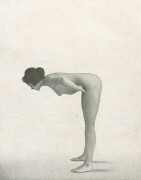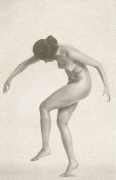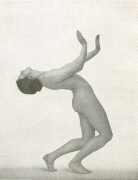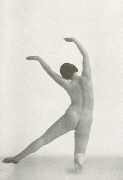
Figure Drawing EbooksDora Menzler's
|
Learn How to Draw Perspective
Purchase the ebook by clicking the "Buy Now" button at the bottom of the page.
After completing the purchase you will be directed to a web page which will give you a link to the download site.

| Kräftigung der Rückenmuskulatur der Frau - Lehrtafel A
Strengthening the back musculature. Eight poses and drawings in pencil. 95 Cents DOWNLOAD THE E-BOOK |

| Kraftigung der Bauchmuskulatur der Frau - Lehrtafel B
Strengthening the abdominal muscles. Ten poses and drawings in pencil. 95 Cents DOWNLOAD THE E-BOOK |

| Korrektur der Brustwirbellaule und Erweiterung des Brustkorbes der Frau - Lehrtafel C
Chest and thorax. Twelve poses and drawings in pencil. 95 Cents DOWNLOAD THE E-BOOK |

| Ausbildung der Seitlichen Rumpfmuskulatur der Frau - Lehrtafel D
Training of the lateral trunk musculature. Ten poses and drawings in pencil. 95 Cents DOWNLOAD THE E-BOOK |

| Entspannungsubung der Frau - Lehrtafel E
Relaxation exercise. Eleven poses and drawings in pencil. 95 Cents DOWNLOAD THE E-BOOK |
|
Purchase all five ebooks for $1.95 DOWNLOAD THE E-BOOK |
Die Schonheit Deines Korpers References to Dora Menzler can be found at the Scholaship edition of Empire of Ecstasy Nudity and Movement in German Body Culture, 19101935 by Karl Toepfer see and edition of the web here. � �D�o�r�a� � �M�e�n�z�l�e�r� � �Giese, Hagemann, and Menzler implied that the most powerful sign of a unique personality is nude dance. Berber's dance did not contradict this implication, but it was "more naked" than nude dance elsewhere in constructing a perception of uniqueness as a condition of stark aloneness, estrangement, and perversity. Nude dance was no cure for cocaine; it was not modern because it had any therapeutic effect. For Berber, nude dance aestheticized her sickness, and by doing so, by aestheticizing the addictions, compulsions, and mechanized rhythms defining the modern body, her dance anticipated postmodern sensibility; it was an almost satiric critique of the pretentions to a healthy, modern identity that both eurhythmic consciousness and Nacktkultur sought to achieve. Pleasure for the modern audience (not just the dancer) depended on aestheticizing, through nude dance, the symptoms of an incurable aloneness that makes the body modern. �N�u�d�e� �d�a�n�c�e� �i�n� �W�e�i�b�l�i�c�h�e� �K�o�r�p�e�r�b�i�l�d�u�n�g� �e�m�e�r�g�e�d� �m�o�r�e� �a�s� �a� �f�i�g�m�e�n�t� �o�f� �r�o�m�a�n�t�i�c� �f�a�n�t�a�s�y� �t�h�a�n� �a�s� �a� �serious� �m�o�d�e� �o�f� �p�e�r�f�o�r�m�a�n�c�e� �t�h�a�t� �m�o�d�e�r�n� �s�o�c�i�e�t�y� �c�o�u�l�d� �a�c�c�o�m�m�o�d�a�t�e�.� �T�h�e� �i�n�t�e�n�s�i�f�y�i�n�g� �e�r�o�t�i�c�i�s�m� �result�i�n�g� �fr�o�m� �t�h�e� �n�u�d�e� �p�e�r�f�o�r�m�a�n�c�e� �o�f� �d�a�n�c�e� �o�r� �d�a�n�c�e�l�i�k�e� �m�o�v�e�m�e�n�t�s� �c�o�u�l�d� �w�e�l�l� �j�e�o�p�a�r�d�i�z�e� �t�h�e� �innocen�c�e� �femini�s�t�s� �w�i�s�h�e�d� �t�o� �a�s�c�r�i�b�e� �t�o� �t�h�e�i�r� �N�a�c�k�t�k�u�l�t�u�r� �.� �A� �m�o�r�e� �s�o�b�e�r�i�n�g� �v�i�e�w� �c�a�m�e� �f�r�o�m� � �D�o�r�a� � �Menz�l�e�r� �,� �whose� �M�e�n�s�e�n�d�i�e�c�k�-�i�n�f�l�u�e�n�c�e�d� �s�c�h�o�o�l� �i�n� �L�e�i�p�z�i�g� �w�e�n�t� �i�n�t�o� �o�p�e�r�a�t�i�o�n� �a�b�o�u�t� �1�9�0�8�.� �D�i�e� �Schoenhe�i�t� �d�e�i�n�e�s K�o�r�p�e�r�s� �(�1�9�2�4�)� �l�i�n�k�e�d� �h�e�r� �t�e�a�c�h�i�n�g� �t�o� �f�e�m�i�n�i�s�t� �e�f�f�o�r�t�s� �t�o� �c�o�n�s�t�r�u�c�t� �a� �"�n�e�w� �i�d�e�a�l� �o�f� wom�a�n�.�"� �M�e�n�z�l�e�r� �t�h�o�u�g�h�t� �t�o�o� �m�u�c�h� �n�a�k�e�d�n�e�s�s� �c�o�u�l�d� �d�i�s�s�i�p�a�t�e� �t�h�e� �p�h�y�s�i�c�a�l� �v�i�t�a�l�i�t�y� �t�h�a�t� �f�e�m�i�n�i�s�t� �b�o�d�y� �cult�u�r�e� �s�o�u�g�h�t� �t�o� �c�u�l�t�i�v�a�t�e�:� �"�N�a�k�e�d�n�e�s�s� �m�u�s�t� �n�o�t� �l�e�a�d� �t�o� �a�p�a�t�h�y�"� �(�4�1�)�.� �T�h�e�r�e�f�o�r�e�,� �i�t� �w�a�s� �n�o�t� �n�e�c�e�s�s�a�r�y� �for� �w�o�m�e�n� �t�o� �p�e�r�f�o�r�m� �a�l�l� �g�y�m�n�a�s�t�i�c� �a�c�t�i�v�i�t�i�e�s� �i�n� �t�h�e� �n�u�d�e�.� �T�h�o�u�g�h� �s�h�e� �d�i�d� �n�o�t� �s�p�e�c�i�f�y� �w�h�a�t� �a�c�t�i�v�i�t�i�e�s� �requ�i�r�e� �n�u�d�i�t�y�,� �t�h�e� �i�m�p�l�i�c�a�t�i�o�n�,� �d�e�r�i�v�e�d� �l�a�r�g�e�l�y� �f�r�o�m� �t�h�e� �p�h�o�t�o�d�o�c�u�m�e�n�t�a�t�i�o�n�,� �w�a�s� �t�h�a�t� �n�u�d�i�t�y� �w�a�s� �a�p�prop�r�i�a�t�e� �o�n�l�y� �i�n� �s�o�l�o� �o�r� �g�r�o�u�p� �s�t�r�e�t�c�h�i�n�g� �e�x�e�r�c�i�s�e�s�.� �B�y� �c�o�n�t�r�a�s�t�,� �S�u�r�e�n�,� �K�o�c�h�,� �a�n�d� �G�i�e�s�e� �l�i�n�k�e�d� �n�u�d�i�t�y� �t�o� �p�e�r�f�o�r�m�a�n�c�e� �i�n� �s�p�o�r�t�s� �(�s�u�c�h� �a�s� �a�r�c�h�e�r�y�,� �j�a�v�e�l�i�n�,� �r�o�w�i�n�g�,� �w�r�e�s�t�l�i�n�g�,� �a�n�d� �w�e�i�g�h�t�l�i�f�t�i�n�g�)� �a�s� �w�e�l�l� �a�s� �d�a�n�c�i�n�g�. Menzler , however, asserted emphatically that "dances and dancelike movements which result in heightened emotion should in no case be performed naked." But who felt this ominous "heightened emotion"?‹the performer? the (female?) spectator? or both? And what sort of dancelike movements actually heightened emotion? Was the power of these mysterious movements independent of the music that normally accompanied them? Virtually all Nacktkultur theorists implicitly assumed that dancelike movements projected a potent erotic significance independent of the narrative or musical contexts that motivated them. Yet the identity of these movements remained obscure, veiled in a rhetoric of ambivalence toward the unnamed consequences of nude dance. On the one hand, the theorists claimed that body culture reached its highest manifestations through dance and through nudity; on the other hand, they discreetly worried that any convergence of dance and nudity would lower the authority of either to construct a modern, liberated identity for humanity. A few representatives of feminist Nacktkultur resolved the paradox by blurring distinctions between dance and gymnastics, and even the photodocumentation in Menzler's book did not make clear the difference between gymnastic and dancelike movements. Although the bodies she depicted performed in untheatricalized, outdoor spaces, the actions were aesthetic in that they focused attention entirely on the bodies performing them, not on the movements themselves (Hagemann's abstractionism) nor on intragroup dynamics (Hagemann's homoeroticism). However, Menzler did include separate photos of men performing the same exercises as the women, suggesting that gymnastics was a way to resolve differences between men and women associated with feminism. With this strategy, nudity, dance, and gymnastics were subordinated to a peculiar image of a healthy, beautiful body that was desirable without being "seductive," without being a calculated assertion of desire, without being an invitation, a promise, a challenge, or a dare. It was a strategy that completely deflected the burden of desire away from the performer and onto the spectator. More precisely, it intimated, in spite of a ceaseless ambition to document it visually, that Nacktkultur innocence needed no spectator, that those who engaged in it were oblivious to the presence of a critical other. Genevieve Stebbins (18571915) studied under MacKaye in New York. In books published in the 1890s, she modified the Delsarte system by incorporating theories of breathing and rhythmic movement to produce what she called "harmonic gymnastics" for female students. Stebbins's emphasis was not on developing a large vocabulary of expressions for use on the stage but on cultivating an ideal convergence of female hygiene and beauty. It was she who first associated the "natural" female body with the wearing of Grecian tunics and chitons. A student of Stebbins, Hedwig Kallmeyer (1881?), opened a school for girls in Berlin around 1905, and her students included Dora Menzler and Gertrud Leistikow. |
|
If you are new to PayPal you will be directed to a PayPal sign up page
or you will be allowed to
pay directly by credit card.
|
You will need Adobe Acrobat Reader (c) to view the PDF file.
If you do not have a copy of Adobe Acrobat Reader you may download a free copy of the latest version here:
Acrobat Reader Download Site
If you experience any trouble downloading the e-book please click on this link: Detailed Download Instructions
If you are still experiencing trouble email me at:lifedraw2005@yahoo.com and I will contact you to help with the download or email you the file.
|
If you prefer to purchase Books A, B, C, D or E on CD on CD for $8.95 each, or all five on CD for $24.95 or if you prefer to pay by check, please email me at: lifedraw2005@yahoo.com include your name and address and I will contact you with instructions. |
The series "Korperchulung der Frau" used in this e-book and the images in it are believed to be in the public domain based on their age and publishing date. If you have information to the contrary please email me: lifedraw2005@yahoo.com The new drawings based on the source material are copyright 2005 by figure-drawings.com
|
Search for an original edition at
Abebooks.com
Die Schonheit Deines Korpers (Hardcover)
by Dora Menzler at Amazon.com |
Preishits aus jeder Kategorie bei bol.de |

